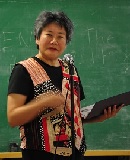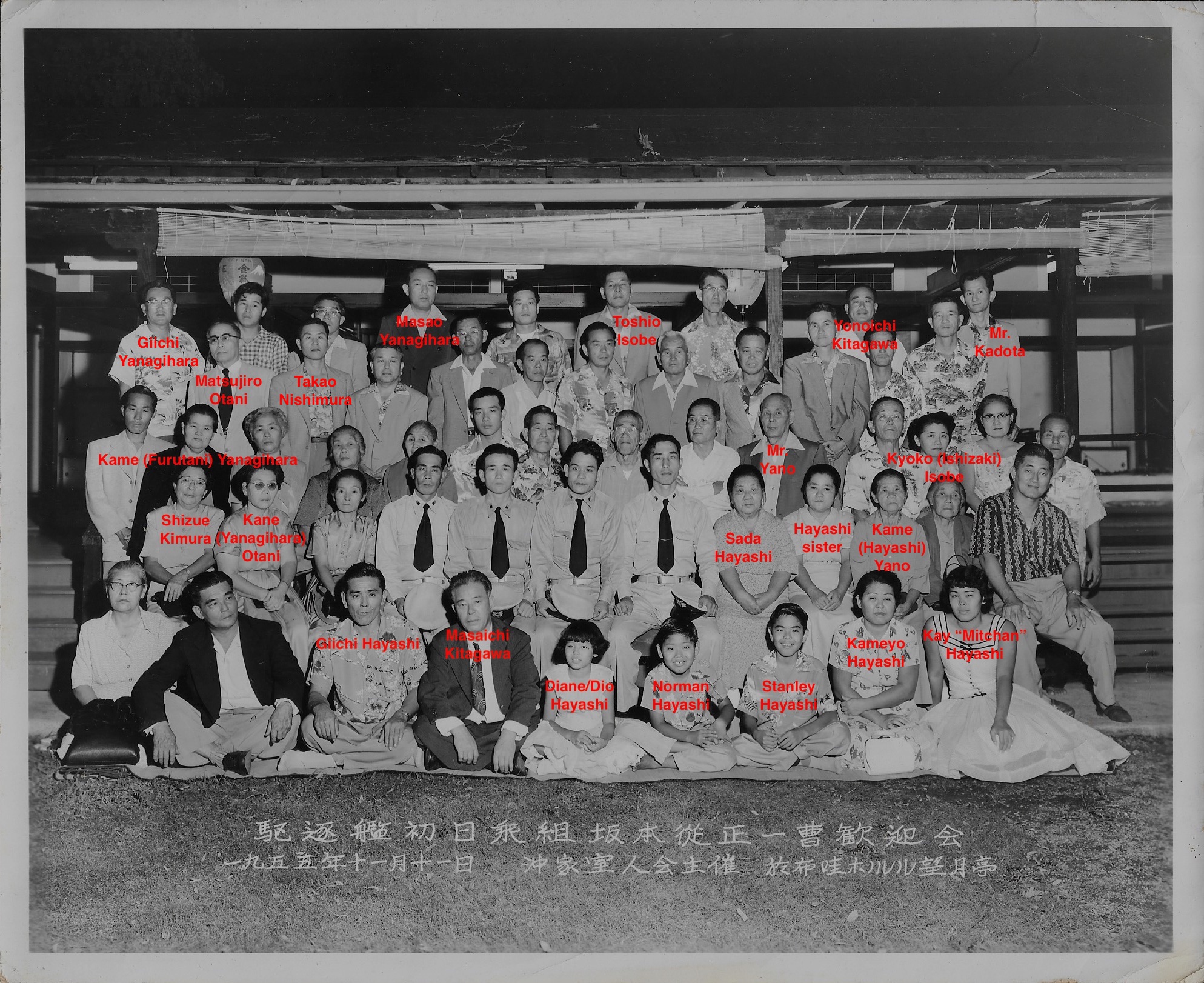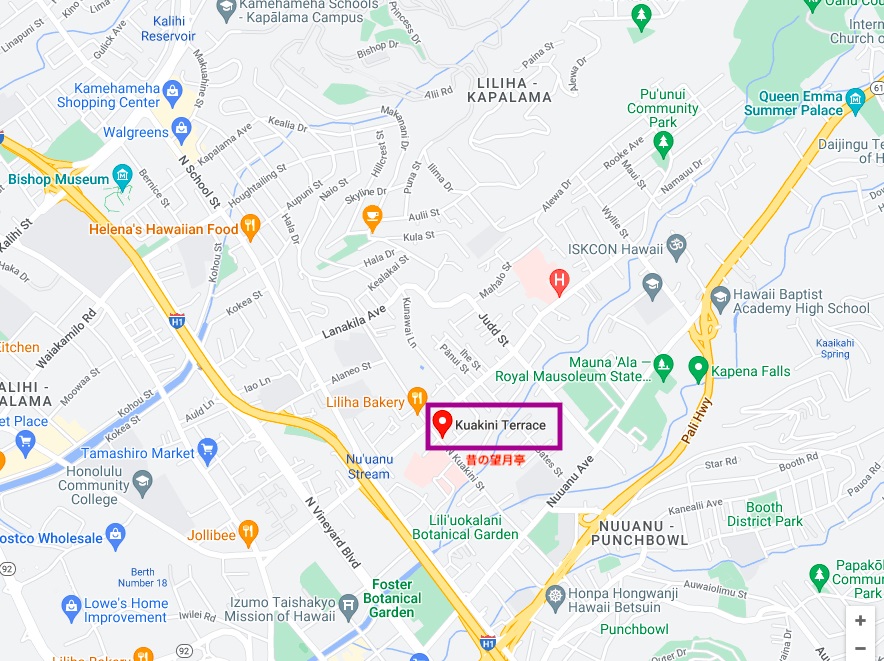



Hello Mr.Yagi
Another interesting photo came out. November 11, 1955 The Hawaii Okikamuro club gathered at Mochizuki-tei. Mochizukitei was a famous restaurant in Honolulu called Liliha.
article from the Hawaiian newspaper (Honolulu Star-Advertiser November 13, 2013) is attached.
Following people are recognized by club member.
Marie Otani
Matsujiro Otani (grandfather)
Kane (Yanagihara) Otani (grandmother)
Shizue Kimura
Kame (Furutani) Yanagihara
Amy Yamashita
Toshio Isobe (uncle)
Kyoko Isobe (aunt)
Lorraine Kadota
her father
Colleen Morimoto
Kyoko (Ishizaki) Isobe (mother’s cousin)
Kyoko’s mother
Kyoko’s husband
Stacey Hayashi
Giichi Hayashi (grandfather)
Kameyo Hayashi (grandmother)
Stanley Hayashi (father)
Diane/Dio Hayashi (aunt)
Norman Hayashi (uncle)
Kay "Mitchan" Hayashi (aunt)
Sada Hayashi (great-grandmother)
Kame (Hayashi) Yano (great-grandmother)
Hiram Kitagawa
Yonoichi Kitagawa (father)
Masaichi Kitagawa (uncle)
Hayashi family (third cousins)
Yano family (third cousins)
Loren Nishimura
Takao Nishimura (father)
Giichi Yanagihara
Only the children are smiling.
You can clearly see black and white photos over the years.
Aloha
Marie Otani
p.s.
Stacy Hayashi recognized main guest 'Osamu Sakamoto'.
Her message. "Osamu Sakamoto was the nephew of Sada Hayashi. Kameyo Hayashi gave the land so that the Sakamoto family would take care of the Hayashi family graves on Okikamuro. Reverend Niiyama confirmed this."
p.s.2
Information from Loren Nishimura is added.
from (Honolulu Star-Advertiser November 13, 2013)
One of the most famous [teahouses] was Mochizuki Tea House in Liliha, on Kunawai Lane below Judd Street.
James Fujita wrote me that his grandfather Hisaichi Fujita was the owner and operator of Mochizuki Tea House from the 1920s to 1955.
"When he passed away, my father, George Hideo Fujita, and his sister Fumiko Fujita operated as partners until the fall of 1973 when it closed its door permanently."
Longtime Honolulu resident Tim Fern recalls a nondescript parking area at Mochizuki, walking through an otherwise plain gate, yet immediately into a tranquil scene one might expect to see in Japan.
"The individual rooms had tatami mats from wall to wall, with low eating tables. A stack of printed, cleaned and ironed kimonos were at the entrance to each room. Of course, shoes were left at the door.
"The six rooms hovered around a beautifully sculpted koi-filled pond," Fern says. "Sliding doors and window were papered, no furniture except the low table and futon pillows.
"Kimono-clad waitresses suddenly appeared to seat guests, hibachi-cook food and serve an otherwise scrumptious meal.
"The original Mochizuki Tea Garden was located in Waikiki," Fujita says. "My grandfather bought it from Mr. Mochizuki and moved it to property he found in Liliha."
Mochizuki Tea House was more than a restaurant. There were six small Japanese-style houses where parties could dine privately and a main dining building for big parties up to 100 people.
"In the 1920s, people could take a bath first in a big Japanese-style furo, change into a yukata and go down to the dining room where they would be served sukiyaki, sashimi, tempura and any other dish they wished to order along with soup, tsukemono, and, of course, rice. My favorite dish on the Mochizuki menu, while growing up, was the stuffed lobster."
Many Japanese celebrities, movie stars and singers also dined at Mochizuki Tea House. "Adm. Kichisaburo Nomura of the Imperial Japanese Navy and later ambassador to the United States dined here. After the war, Cmdr. Mitsuo Fuchida, leader of the air assault on Pearl Harbor, visited Mochizuki.
By the ’70s the days of our parking lot filled with tour buses seemed to have peaked.
"A real estate developer approached my father and aunt and told us he wanted to build a residential condominium on our property."
The Kunawai Terrace condominium now stands on the 1-acre property that was once Mochizuki Tea House. The developers capped the natural bubbling spring water but left a small pond at Kunawai Springs Park adjacent to where Mochizuki stood. They also created a series of water features inside the condominium courtyard.
"In October of 1973, I said goodbye to the only home I knew," Fujita concludes. "It broke my heart to see it being torn down. Today, several generations have been born who have no recollection of Mochizuki Tea House."

Place where Mochizuki restaurant located